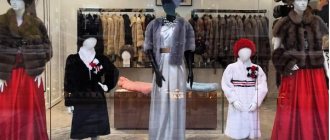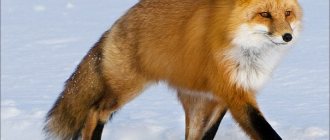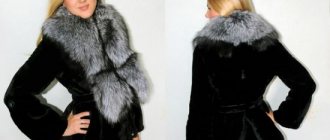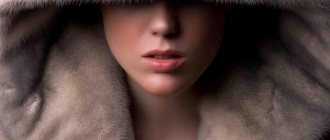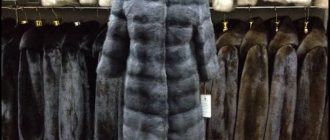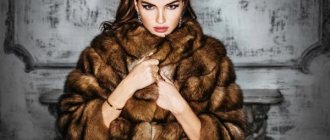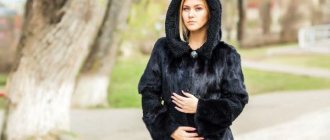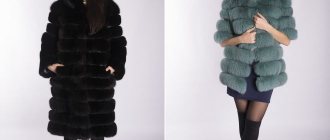Trends are determined not only by styles. An important criterion for the best choice is the fashionable colors of mink coats. They are often determined by the place of origin of the fur, its rarity, and the peculiarities of dressing and selection of skins. Subtleties and nuances known only to designers and true fur connoisseurs should not be a secret for a true fashionista.
Moreover, the rules for choosing a good fur coat color differ significantly from the rules for choosing ordinary things. Just knowing your own color type is not enough.
Here you will find out the names of the fashionable shades of mink coats, you can see their photos and read a description of each color.
Black mink coats and photos of graphite-colored models
To begin with, it is worth clarifying that all colors are considered relevant today - from coal-black Blackglama to numerous shades of white. Light shades not only allow you to reveal the style; it is not without reason that the most luxurious models are made from light-colored furs. They allow you to show all the beauty and nobility of the fur itself.
Of course, no trend can dislodge Blackglama - this is one of the most recognized and popular furs of natural black color, sometimes with a reddish tint - it is also called the “color of oil”. But the fact is that the popularity of this fur also has a downside. It is often counterfeited, inexpensive models are made from fakes, and therefore it is not surprising that black fur is an overly popular option.
But you really want your own fur coat to be unique. In defense of the real American Blackglama, it is worth saying a few words. Fur is indeed luxurious and expensive, but if you choose this shade, choose the most complex, designer style.
When deciding which color is best for a mink coat, first of all, you should not go to extremes. Just like shades of black, all snow-white tones are also very insidious, primarily due to impracticality and excessive expressiveness. Things that are too bright tend to quickly bore their owner. But within the boundaries of these colors lies a whole range of magnificent natural shades, among which you can choose your own and unique one. But first, you shouldn’t destroy the image you’ve created over the years and choose a fur shade just because it’s in fashion. To make the fur really suit your face, use the color scheme that you usually stick to – without drowning it out, but without depleting it either.
Carefully study all the shades that suit your personal color type, there are many options, even among the popular ones, very dark shades. Look how impressive the graphite-colored mink coat is in these photos:
American Palomino and Pearl Minks
The beige American Palomino mink is a simple recessive. The best type of color is smoky beige with a bluish tint. However, quite often there are undesirable orange or yellow shades in the color, which greatly depreciate the value of the skin. The animals are fertile, large in size, and vital. Eyes lingonberry color. When crossed with standard ones, the color is inherited, as when crossed with royal pastels.
American palomino mink
Palomino participated in the breeding of the most valuable, widespread pearl mink.
To obtain pearl minks, American palominos are crossed with silver-blue or sapphire ones, after which the first-generation crossbreeds are crossed with each other and no more than 6-7% of pearl-colored puppies are produced in the offspring. Pearl can hereditarily combine the color factors of palomino, platinum and Aleutian; It has a smoky color with a bluish tint of fluff, looking like an ennobled palomino color. The animals' eyes are pink, fertility and vitality are good.
Pearl mink
Within the color range, three main tones can be distinguished:
- darker - royal pearl;
- light - usually represented by ordinary pearl ones, carrying the Stuart factor;
- especially light - with almost white fluff, usually carrying the “breath of spring” factor.
The last two types have highly developed spotting, and it is not advisable to use them for reproduction within themselves, since they are infertile due to the embryonic death of puppies. Usually they mate with darker ones - royal pearls.
On a note!
When numbers are limited, they can be successfully reproduced by crossing pearl males with palominos or silver blue females, then backcrossing the first generation females.
When breeding pearl minks using palomino, a significant portion of the offspring are produced with a clear palomino tint, which is undesirable. Conversely, when bred to good silver-blue females, in most cases the offspring will have an excellent smoky bluish hue.
Among the palominos there are a number of colored varieties resulting from crossing with various pastel minks and then crossing the crosses, including: the palomino royal pastel with a light yellow coloration and pink eyes; Ungava Palomino with a very light color and orange tint, with pink eyes; Socloth-pastel-palomino with light gray coloring, with dark eyes.
Mink coats in mahogany and walnut colors (with photo)
For example, the color of a mink coat “mahogany” is a classic of fur fashion. The shade got its name due to the rich tones characteristic of redwood species growing in South America.
The rich dark beard-brown tone of the fur is the result of many years of selection, and it’s not just about beauty. This type of fur is rightfully considered the warmest and can withstand very severe frosts. There is one small “but” - the price for natural “mahogany” can be significantly higher than for any other fur. But it justifies it in full, the fur is not only warm, but also almost eternal.
A more delicate shade of brown is “walnut”; the color of this mink coat is closest to the natural shade of the fur. By the way, almost half of all fur coats in the world are made from it, but it also has its own subspecies and characteristics.
For example, Finnish mink fur (scanglow mink) has a very beautiful shade of hot chocolate.
Scandinavian brown mink is labeled (demi buff) - it is a beautiful rich nutty tone of medium intensity.
Of particular interest are two exclusive subspecies of this fur. “Walnut-mahogany” is a rich and bright, as well as rare and, therefore, expensive walnut-marble fur: light brown with a chocolate tint. You can choose your own shade from such a variety to suit any color type; it’s not for nothing that brown-walnut shades are considered universal. Unlike too dark tones, they do not add unwanted age and solidity, but at the same time they have all the advantages of dark furs and can be successfully combined into any wardrobe. A walnut-colored mink coat like the one in the photo is an example of style and elegance:
Mink coat colors: mocha and cappuccino
Brown mink coats are a constant fashion hit. Suffice it to remember that brown itself has about fifty original shades, and fur manufacturers quite actively use this rich range. Today it is fashionable to depart from the classical canons, while maintaining the highest standards of both design and natural fur color.
A great example is a mocha mink coat. The intense yet delicate shade gets its name from, of course, coffee. There can be as many shades of fur as there are varieties of coffee itself. Soft gradient color transitions - from soft brown to golden - look great, both in the original, uncut form, and with any type of modern processing. Perhaps this is why designers love “mocha” so much, creating both original and classic, almost standard models from it.
Fur looks great in shortened models, such as peacoats and parkas, as well as very short ones, which are called “autolady”.
A cappuccino-colored mink coat also has a similar “coffee” name. This is the same as “mocha” universal, and at the same time luxurious fur, which allows you to accurately create a respectable and at the same time modern image. The fashionable colors of mink coats in these photos are a reflection of the latest trends:
Mink coats - “cross sections” in sable color (with photo)
One of the most tempting and interesting shades of brown is represented by models made from sable mink fur. This is not a fake or fiction, but a special type of fur and even the assembly of the model. Sable fur is one of the most expensive in the world; these animals are not bred in captivity, hence the exclusivity and price. No wonder he is called the king of wild fur.
But there are varieties of mink – the best are considered Scandinavian and Russian – whose fur perfectly imitates precious sable. The skins are a delicate chocolate color with beige stripes along the edges and have a thick and fluffy pile. Models made from such fur are never assembled “lengthwise”.
The desired “sable color” is given to a mink coat by a “cross stitch,” that is, an assembly in which the skins are sewn together horizontally. As an option, such models are complemented with narrow transverse strips of leather. In any case, you get a very impressive and exclusive fur product. Mink coats of sable color, such as those in the photo, are real works of art:
Mink coat colors: beige, pastel and powder
What do words like “sapphire” and “topaz” tell you? Of course, these are precious stones, but not only - these are also shades of fashionable mink coats in pastel colors. There are many of them in modern fashion, ranging from champagne shades to cocoa and palomino tones.
“Palomino,” by the way, is one of the most refined and delicate shades, very popular in new trends.
The peach-beige color of such mink coats allows you to demonstrate the richness and beauty of the fur texture. It is neutral and at the same time rare, and looks aristocratic both in classic models and in the most avant-garde ones.
Light shades are always elegant; this quality is not overlooked by designers who feature models in colors that are not typical for a practical winter wardrobe.
Such as powder-colored mink coats - delicate, slightly smoky and dusty fur with a light pink tint looks like a real jewel.
Beige minks obtained as a result of crossing
- Perrin Buff - light beige mink with a pinkish tint, with dark eyes. A simple recessive form, developed by crossing palominos with wild minks. Used in crossbreeding to obtain more valuable fur colors.
- Swedish buff (Swedish palomino) - first obtained in Sweden by breeding socloth-pastel minks. The Swedish Buff has light brown, beige (cafe with milk color) fur color.
The skins are steadily in demand among consumers. When crossed with Royal Pastel, the puppies have a standard color.
- Ienz (Finnish White) - in color it is a cream type of American Palomino. The eyes are pink. Used in crossbreeding to obtain more valuable fur color.
- Colton Beige - with light beige fur, bred by crossing Royal Pastel with Finnish White (Jenz).
- Hope - beige minks with light beige fur, with lightened down, the color of their fur is very similar to light pearl ones. The eyes are pink.
Beige Hope Mink
Carry the heredity of platinum, Aleutian and amber-golden colors.
- Lavender - have light brown fur with a blue tint, turning into a pale lilac color. When breeding them, Aleutian minks and moil-buffs took part.
Mink lavender
- Eolen - with gray-beige pubescence, obtained by crossing silver-blue (platinum) with amber-golden. Animals with good fertility. The eyes are dark.
- Swedish Palomino Platinum (Swedish Buff X Silver Blue) - similar in color to pearl, have dark eyes.
- Swedish Palomino - Aleutian (Swedish Buff X Aleutian) - very similar in color to lavender; eyes are red.
- Swedish palomino – royal pastel (topal) – light brown, red-eyed. It has not received wide distribution.
- Cream buff - animals have a light cream color (the color of an eggshell), pink eyes. Split off during mating moil-buff.
- Pano Buff - has a light beige color in a medium tone between the Palomino and Perrin Buff colors, as a result of crossing which it appeared.
- Blue beige (silver-blue X socloth-pastel) - similar in appearance to light pearl.
Fawn mink coats and pearl-colored models
A fawn mink coat will look a little more conservative, but no less stylish.
The pinkish-beige shade of fur is considered more classic, and meets timeless standards. Impeccable options for the styles of such models are elongated pea coats or beautiful “trapezes”, gathered along the cut lines.
By the way, all light-colored furs (from high-quality manufacturers!) are natural, and not bleached or dyed. But their production is more difficult and costly than ordinary dark ones. Therefore, the high price, for example, of a pearl-colored mink coat is justifiably higher than many others.
Clothing accessories
Pearl mink adds soft femininity to any model . A short fur coat with a hood and a wide leather belt tied with a bow will look especially cute and girlish.
A single button brooch made of rhinestones looks impressive: the icy glow of large stones sets off the delicate charm of mink.
Pearl fur is universal: a warm, creamy shade will suit any complexion without distorting it, and beauties with snow-white skin need not be afraid that they will look pale or sallow in such a fur coat.
Bright individuals of the southern type can also safely choose a pearl-colored mink - it will serve as a worthy frame for their burning charm.
[Total: 2 Average: 3.5/5]
"Pearl" gray mink coats
The pearl shade is considered truly rare in the world of fur fashion: a subtle gray tone on snow-white fur complements the beautiful natural shine and shimmer of the pile - truly luxurious fur. It looks very beautiful and creative in models assembled transversely or diagonally, as well as in combination with fluffy snow-white fur - for example, arctic fox.
The gray color of a mink coat can be any of a dozen existing shades. Furriers suggest choosing a shade based on the undertone of the fur; it can be either bluish or white, but the most popular is graphite.
Such models are at the same time universal - unlike most light fur items, they are not so capricious to care for, but at the same time, they always look very respectable and elegant. In addition, gray has been the “new black” for several seasons in a row. And this model will fit perfectly into a fashionable winter wardrobe.
This kind of fur, by the way, is somewhat cheaper than other pastel ones, and is used to make models that are assembled in “plates” to create a single fur fabric. By the way, all gray shades go well not only with classic styles, in which expensive fur looks beautiful. They perfectly highlight trendy styles designed for youth looks.
Cropped parkas or bombers made from this fur are an excellent solution for a youth wardrobe.
In the most daring collections, and therefore forecast for several seasons ahead, today there are practically no models made of snow-white fur. Designers left it for more frivolous styles - boas and stoles. The white color has been actively replaced by pastel colors - complex and diverse.
By the way, such shades have a serious anti-aging effect; unlike dark models, they will visually “subtract” several years from your age.
How to choose the right fur coat color for your figure
Whatever the new fashion trends, every woman chooses her favorite outfit, depending on her lifestyle, financial capabilities, taste, and body shape. Often you have to take into account which color is the most practical - a floor-length light fur coat is inappropriate on public transport, and short jackets won’t last long in winter. Modern fashion is democratic, and almost all styles are in trend, but it is unwise not to take into account height and build when choosing a model.
Slender women can afford any options without restrictions. “Cumpies” have to somewhat limit themselves in the choice of colors: light, especially warm shades, add volume; You should limit yourself to darker (chocolate, nut, cappuccino) or cold (blue, graphite, iris, sapphire, crushed ice). Don't get hung up on black - it doesn't always make you look slimmer. You should not buy dyed fur coats, except for elegant dark blue or purple products. Some styles should also be abandoned: flared models, short jackets in the style of a car lady or bombers - they will not add grace. But a straight silhouette or trapezoid seems to elongate the figure.
Fashionable mink coats in natural colors and their photos
There is a huge range of shades, which is easy to get confused even for those who understand fur. Moreover, manufacturers often come up with their own names for the colors of mink coats. This is, in fact, nothing more than a marketing ploy.
Of course, it’s more pleasant to know that your “mink” is a unique “iris” or “stardust” color. Although these are just shades of gray and brown... Such innocent tricks can be forgiven.
But in order to really understand the colors of this fur, it is worth remembering that the natural color of a mink coat can be anything: from white to blue black.
And in this range, both soft coffee and powdery shades are perfectly represented. Even in such a popular spectrum as brown, experts count at least a dozen original shades.
The second thing to remember is that this fur has long been bred on an industrial scale, and it is much more pragmatic to create a new breed than to dye the fur. It is still quite expensive, and painting cheapens the appearance and reputation of products made from it.
Stylish looks
A mink coat is not just a fashion trend, it is a style decision that reflects the essence of a woman. When buying a beautiful thing, a woman decides what color mink will suit her, what cut and style will highlight her individuality. Young girls have more choice than older ladies. Dyed fur, creative styles, combinations of different colors, short coats, fur jackets, hoods, funny kangaroo pockets create a unique youth style with bright images. Young people wear classics with pleasure.
It is easy for women to create their own exclusive look using color combinations. Black and chocolate fur coats are suitable for strict ladies; cool shades of the blue palette create an elegant and slightly detached image; crushed ice is suitable for an airy, gentle woman; mahogany or walnut will support the classic style of its owner; pastel, powder, pearls look expensive and catchy. Well, if you want something unusual, a purple or burgundy fur coat will help out.
Dyed mink coats in blue and light blue
From time to time, tinted and even painted models appear in trends.
For example, such as a blue mink coat - original and, of course, unforgettable. But what is worth considering when choosing such a model. They dye, and at the same time, most often cut the most inexpensive furs, subjecting them to serious chemical treatment. And it’s not even about the environmental friendliness of such fur; any unnecessary impact affects its quality.
This model can hardly be called natural, and it will “live” in your wardrobe for at most a couple of seasons. During this time, it will become fashionable and the quality of the fur itself will make itself felt.
Those who cannot resist exotic shades should pay attention to models made of blue or pinkish fur, it is absolutely natural. Just like the whole pastel range of mink furs. In this case, the art of breeders and furriers plays a role. Such a mink coat of natural color, as in the photo, deserves special attention:
What color is fur dyed?
If a woman is not satisfied with multi-colored mink fur coats in natural colors, then you can choose a bright dyed fur coat. Some will like a red mink coat, like in the photo from the fashion catwalks of Paris, while others will like an unusual blue or fiery red one. Redheads will love a bold green mink coat. Young people love experiments - colored outfits can be very interesting and bright. These colored models are sewn in a youth creative style. When purchasing, you should keep in mind that coloring negatively affects the durability of the skins, they lose elasticity, the fibers break off, and the item will last only a few seasons. The fashion for style and color may pass even earlier - in one or two seasons, so the purchase of such a model should be carefully considered.
